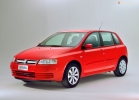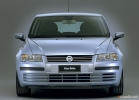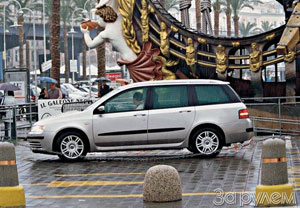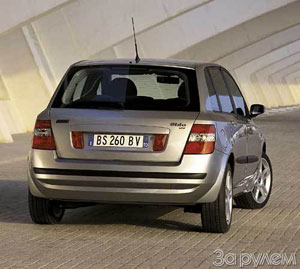Test drive Fiat Stilo 5 doors 2001 - 2006 hatchback
Excuses
Renault and Fiat install a new bar for competitors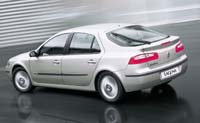 The spring novelties of the Russian Renault Laguna foreign cars of the second generation and Fiat Stilo belong to different categories. The Frenchman performs in the segment D, the Italian machine belongs to a more compact golf class. Nevertheless, there is one feature that unites these models. Both Laguna and Stilo set new standards in their classes.
The spring novelties of the Russian Renault Laguna foreign cars of the second generation and Fiat Stilo belong to different categories. The Frenchman performs in the segment D, the Italian machine belongs to a more compact golf class. Nevertheless, there is one feature that unites these models. Both Laguna and Stilo set new standards in their classes. The Russian premiere of the Renault Laguna of the second generation took place only a year after the start of sales in Europe. The French are extremely scrupulous in car safety, and therefore the company's specialists carefully engaged in the adaptation of the machine to Russian conditions. Nothing was supposed to violate the new Laguna of the only car that received the highest assessment of the EURONCAP crash tests (the most authoritative European organization that engaged in an independent examination of car safety).
According to the European classification, Renault Laguna enters class D, where, frankly, there is something to choose from: Peugeot 406, Opel Vectra, Ford Mondeo, Nissan Primera, Toyota Avensis, decent competitors for all indicators. However, Renault is well aware of the strengths of Laguna: the reference security, a standard equipment and elegant design, with a typical French charm design compared to classmates. The bet is made precisely for these qualities. A three -day acquaintance convinced me that the French are doing this absolutely reasonably.
For the test, the car got a car in the basic configuration: Renault Laguna hatchback with a 1.8-liter engine with a capacity of 123 hp. and a mechanical box (its price is $ 20,500). There is also a 140-horsepower 2-liter version (estimated at $ 21,500, and you will have to pay $ 1000 for the machine). Estate station wagons in a similar configuration cost $ 1000 more.
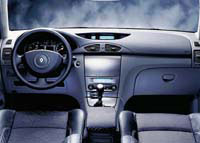 On the deserted section of the highway at a speed of 150 km/h, I sharply hit the brakes. The safety belt clasped the body. On the instrument panel, the emergency light bulb automatically blinked. The car's nose sat down slightly, and Laguna obediently, without a scouring and a screech of the tires stopped. The lack of vibration on the brake pedal, which usually occurs when the anti -lock system (ABS) is triggered. I even doubted whether it was installed on an ABS car. But then why did the wheels not blocked on a wet road (just a light rain) and the car did not enter? Studying the instructions for the car, I understood the reason for the stability of Laguna: the car is seriously equipped with an emergency braking system. ABS is configured in such a way that with a sharp press on the pedal in the brake system, the maximum pressure is maintained in contrast to most other systems in which the brake pedal is forcibly squeezed when the wheels are blocked, and the maximum pressure is retained until the driver completely releases the brake pedal. The emergency gear with sharp braking turns on automatically, preventing cars running behind. The brakes of the car at first seem too sharp, but then you understand that this is good.
On the deserted section of the highway at a speed of 150 km/h, I sharply hit the brakes. The safety belt clasped the body. On the instrument panel, the emergency light bulb automatically blinked. The car's nose sat down slightly, and Laguna obediently, without a scouring and a screech of the tires stopped. The lack of vibration on the brake pedal, which usually occurs when the anti -lock system (ABS) is triggered. I even doubted whether it was installed on an ABS car. But then why did the wheels not blocked on a wet road (just a light rain) and the car did not enter? Studying the instructions for the car, I understood the reason for the stability of Laguna: the car is seriously equipped with an emergency braking system. ABS is configured in such a way that with a sharp press on the pedal in the brake system, the maximum pressure is maintained in contrast to most other systems in which the brake pedal is forcibly squeezed when the wheels are blocked, and the maximum pressure is retained until the driver completely releases the brake pedal. The emergency gear with sharp braking turns on automatically, preventing cars running behind. The brakes of the car at first seem too sharp, but then you understand that this is good. On the straight and in gentle turns, Laguna holds the way perfectly. The tires cling to asphalt tightly. You can knock down a car from the course in a turn only in one case if you sharply drop the gas and energetically turn the steering wheel. Then the back of the rear axle is irreversible. But if the car is equipped with a contrasting ESP system (it is installed regularly on Laguna Universal), then the matter will not reach the introduction.
All these systems belong to the arsenal of active security tools, and they can be tested in practice. Passive safety of the car's ability to preserve the life and health of passengers in accidents is evaluated according to the results of crash tests, where mannequins are used as experimental rabbits.
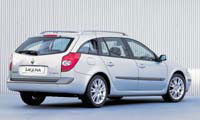 Renault Laguna was the first car to make the highest rating of five stars according to the EURONCAP methodology (see certificate). Renault has a special approach to the protection of drivers and passengers in the accident: designers seek to achieve as smaller body deformations in a collision. For this, the Laguna II frame is reinforced with additional 70 kg of super -strength steel. Nodes located in the engine compartment (engine, gearbox, battery, vacuum brake amplifier, air filter housing, etc.), when impact, do not prevent the programmed body deformation.
Renault Laguna was the first car to make the highest rating of five stars according to the EURONCAP methodology (see certificate). Renault has a special approach to the protection of drivers and passengers in the accident: designers seek to achieve as smaller body deformations in a collision. For this, the Laguna II frame is reinforced with additional 70 kg of super -strength steel. Nodes located in the engine compartment (engine, gearbox, battery, vacuum brake amplifier, air filter housing, etc.), when impact, do not prevent the programmed body deformation. Equipping the car with pillows and seat belts with pretensors (at the time of the accident they press the body more tightly to the chair) unprecedented in this class. Inflatable pillows for the driver and passenger are adaptive: depending on the strength of the impact, they are inflated with varying degrees of stiffness. The number of pillows, including curtains to protect the head during side collisions and pillows to protect the rear passengers (they are built into the backs of the seats), in standard equipment reaches six. Two front and two rear (for lateral passengers) seat belt are inertial and equipped not only with pyrotechnic pretensors, but also by limiters in straps that do not allow belts to put pressure on the chest with a force of more than 600 kg.
Sim-Sim, open!
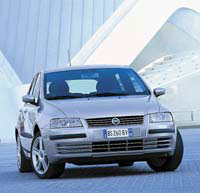 Probably, each driver is familiar with the situation when his hands are busy (each in packing beer for a picnic), but you need to get the keys to the pocket to close the car. In the case of Laguna, you will not have to put packaging with beer on the roof or hood.
Probably, each driver is familiar with the situation when his hands are busy (each in packing beer for a picnic), but you need to get the keys to the pocket to close the car. In the case of Laguna, you will not have to put packaging with beer on the roof or hood. The car is equipped with a free hand function. Instead of the key, the card is slightly thicker than credit, which comfortably falls into the pocket. The system itself determines the presence of the owner when he approaches the car. After that, the locks of the doors, trunk, a hatch of the filler neck of the gas tank unlock automatically, you just need to touch them with your hand. The start of the engine with this system looks very stylish. You insert the card into the slot in the lower part of the central console and press the start button (it is located on a place usual for the ignition key). Approximately the same scheme is used on the latest BMW of the seventh series, and this car, by the way, two classes above Laguna. The engine will start only after the clutch is squeezed. The car recognizes its card by reading the code that has a billion combinations. When, after stopping the car, the driver moves away from him by six eight meters, the system automatically locks the car, seeing off the host with a short sound signal and winking with turning indicators.
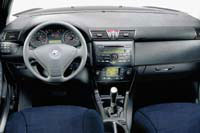 This is not the only pleasant electronic lotion that noticeably facilitates the life of the owner. Laguna is regularly equipped with an on -board computer, rain sensor, a display, which displays an external thermometer with a temperature warning between 3 to +3 (a gland formation point), as well as a tire pressure control function. An audio installation with CD can be controlled without taking off your hands from the steering wheel. Climate control regulates the temperature separately for the driver and passenger.
This is not the only pleasant electronic lotion that noticeably facilitates the life of the owner. Laguna is regularly equipped with an on -board computer, rain sensor, a display, which displays an external thermometer with a temperature warning between 3 to +3 (a gland formation point), as well as a tire pressure control function. An audio installation with CD can be controlled without taking off your hands from the steering wheel. Climate control regulates the temperature separately for the driver and passenger. In general, it was very convenient for me to drive the new Laguna. The long road (during the test had to go from Moscow to Zavidovo and vice versa) is carried very comfortably due to the wide range of adjustments of the chair and steering wheel. There are complaints about the too small screen of the on -board computer in its testimony you have to peer. But otherwise, the combination of devices seemed very pretty and functional. The instruments of instruments look especially beautiful: in the dark, each of them is highlighted in red.
But the decoration of the salon is not impressive. It looks bright and spacious, but at the same time somehow unmarried. A plush fabric is knocked out of an elegant French style in large risk, which trimmed the seats and the door panels. However, the leather finish, judging by the photographs, restores harmony between shape and style.
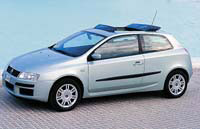 In fact, light dissonance is observed not only in the internal design of Laguna. When I saw the car alive, my first reaction was an exclamation: how beautiful!. But, bypassing the car, I changed my mind. French designers undoubtedly successful the back of the hatchback. The lateral line of the stern is made in the same style as the BMW seamier is very modern and spectacular. But the front part was drawn by designers in the same slightly bored-style bio-style, which was relevant eight years ago.
In fact, light dissonance is observed not only in the internal design of Laguna. When I saw the car alive, my first reaction was an exclamation: how beautiful!. But, bypassing the car, I changed my mind. French designers undoubtedly successful the back of the hatchback. The lateral line of the stern is made in the same style as the BMW seamier is very modern and spectacular. But the front part was drawn by designers in the same slightly bored-style bio-style, which was relevant eight years ago. However, I think even aesthetes will forgive the designers with their indecision. Let the laguna go does not look very stylish, but it has excellent aerodynamics: the aerodynamic resistance coefficient of the hatchback is 0.30, which in combination with an economical engine makes the car very low -digging: the average fuel consumption (urban/suburban cycle) 7.5 l per 100 km.
In principle, a 1.8-liter 16-valve engine is not only efficient. It confidently accelerates the car (up to 100 km/h for 10.7 s), when moving in a dense city stream, it allows you to switch the gears too often, however, when overtaking at high speeds, it is better to stick in a decreasing gear in advance. The syllar unit can be called calm and predictable. If the car is often operated with full load, then it is better not to regret $ 1000 per car with a more powerful 2-liter engine.
The company Autoframos, representing Renault in Russia, expects to sell 100 Laguna cars monthly. I think that a car that has qualities characteristic of models at least by the class above has every chance to find its buyer.
Quite the secret of success
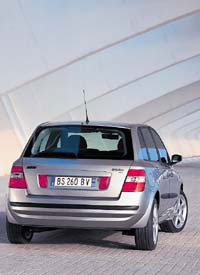 Until the thunder is stuck, the man does not cross this Russian proverb the best suits the Italian car manufacturers. Conducting mainly on the style and accessibility of their cars, the automotivemen with the Apennine, frankly, pay insufficiently attention to quality. But only style and cheapness alone to a modern European consumer is no longer enough. Since the mid-1980s, the share of Fiat Auto cars in the European market has fallen from 14.6% to 10.9%. Now the Italian concern finally realized that there was nowhere to retreat (otherwise you will go to competitors with giblets), and it seems that they changed their attitude to mass models.
Until the thunder is stuck, the man does not cross this Russian proverb the best suits the Italian car manufacturers. Conducting mainly on the style and accessibility of their cars, the automotivemen with the Apennine, frankly, pay insufficiently attention to quality. But only style and cheapness alone to a modern European consumer is no longer enough. Since the mid-1980s, the share of Fiat Auto cars in the European market has fallen from 14.6% to 10.9%. Now the Italian concern finally realized that there was nowhere to retreat (otherwise you will go to competitors with giblets), and it seems that they changed their attitude to mass models. 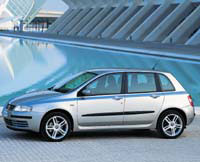 The main hope of Italians Fiat Stilo. Its development and production is invested huge for the not -worn times of the Italian automotive industry money about 1 billion euros. A new plant was built to assemble the car, for the sake of improving the quality of the machine, three quarters of Stilo parts are purchased from specialized manufacturers of components. The Italians are so confident in the reliability of Stilo that, for example, in Russia a two -year guarantee is installed on it without limiting a mileage to a unique offer on the market. For the service, the owner of the car is invited to call no more than every 20 thousand km. At the same time, the cost of service is affordable (TO-1 $ 110, TO-6 $ 315). But perhaps the most unusual in this car is unusually solid to the Fiat level of equipment. By package, the car is, without exaggeration, at the level of models of the representative class. Never before the Italian concern was producing such rich cars.
The main hope of Italians Fiat Stilo. Its development and production is invested huge for the not -worn times of the Italian automotive industry money about 1 billion euros. A new plant was built to assemble the car, for the sake of improving the quality of the machine, three quarters of Stilo parts are purchased from specialized manufacturers of components. The Italians are so confident in the reliability of Stilo that, for example, in Russia a two -year guarantee is installed on it without limiting a mileage to a unique offer on the market. For the service, the owner of the car is invited to call no more than every 20 thousand km. At the same time, the cost of service is affordable (TO-1 $ 110, TO-6 $ 315). But perhaps the most unusual in this car is unusually solid to the Fiat level of equipment. By package, the car is, without exaggeration, at the level of models of the representative class. Never before the Italian concern was producing such rich cars. Stilo replaced the Bravo/Brava tandem in the production program, but there was never a trace of the design of the design of this couple. Fiat designers renounced the connection of generations and the continuity of style: Stilo has chopped, but at the same time elegant lines and swift faces. The ANFAS car looks especially aggressive. This is almost Alfa Romeo (this company is also part of the Fiat Auto concern). The car attracts attention and makes it compare it with the main rival in terms of design Peugeot 307, I recall, the title of the best European car of 2001. In my subjective opinion, the five -door version of Stilo is still somewhat inferior to the spectacity to the French competitor. But regarding the aesthetic advantages of the three -door Stilo and Peugeot 307, one can argue before hoarseness in this discussion is unlikely to identify the winner.
A five -door STILO, which manufacturers represent as a family car, went to the test. With a total wheelbase of 2600 mm, a five -door modification is higher than three -door by 50 mm and 70 mm longer. STILO will cope with the role of the only car in the STILO family. On the back sofa, you get very free, your knees do not touch the front seat. Perhaps, in the second row, the Italian car is one of the leaders in its class. The rear seat is divided into two unequal parts, which are folded independently of each other and move forward and forth along the slopes. If necessary, you can change the angle of inclination of the back, thereby increasing the volume of the trunk. The only inconvenience when placing a low ceiling in the second row: in a car equipped with a hatch, people above 180 cm with a vertical landing will touch the crown of the ceiling.
Folding aircraft type are attached to the backs of the front seats. In the armrest of the rear seats there are advanced stands for cans with drinks. In addition, the back of the right front seat folds forward for transporting long goods. It can be used both as a dining table, and as a passenger’s leg stand, collapsed in the back seat.
Claims to the driver’s place are unlikely to arise even with the most picky expert. Armchairs in a car with rich equipment have electrical adjustments to the height, length, angle of inclination of the back and lumbar support. The adjustment range is sufficient for convenient arrangement of people of any complexion. In the tested car, they were sheathed with skin, but personally this option seemed superfluous to me: the seats do not have severe side support and therefore in the leather version excessively slides. In the basic configuration, the chairs are sheathed with a very solid fabric, similar to the best German samples.
By the way, evaluating the interior of the cabin, you compare Stilo with German cars all the time. No, unfortunately, it has not yet learned how to adjust the details with German accuracy on Fiat, but the Italians came close to the standard in terms of plastic and tissue. Say, the soft and rough plastic of the Stilo instrument panel is very similar to the material from which the TOMW of the third series is made.
Information about the work of the air conditioner, audio installations (and abroad also the navigation system) is displayed on a large information display on the central console. One of the most successful finds is adjustable in two directions and a steering wheel sheathed with leather. Under the invoice with a large and bright Fiat emblem, a pillow is hidden. In total, six pillows, including inflatable window curtains, include standard equipment. In addition, Stilo has in the standard the ASR anti -boom system, ABS with a brake force distribution system, the Brake Assistant system (emergency braking amplifier), and the automatic air recirculation mode. As options (very inexpensive compared to competitors), the stabilization system of the VDC course stability, xenon headlights, cooled boxing in a glove box, parking sensors, rain sensor, a multi -sectioned glass hatch in the roof ... Thus, it can be argued that Stilo has the richest The level of configuration (in the basic version) among golf class cars. The last blow to competitors can be adaptive cruise control, which using the radar automatically supports a safe distance between Stilo and ahead of the drive. This option was previously had only Mercedes S-class and the new BMW seven.
In the movement of Fiat Stilo remained a typically Italian car sharp and active. The motor does not differ in some outstanding characteristics (this is a long-proven 4-cylinder 16-valve engine with a volume of 1.6 liters and a capacity of 103 hp), however, the ratio of gear rates in the checkpoint is selected so that the machine accelerates quite briskly. In gentle turns on numerous interchanges in the third transport ring, the car was very tenacious for asphalt. But with sharp maneuvers, the steering wheel interfered with too light. And the helmet of the helm has a City mode (activated by the button on the central tunnel), after the inclusion of which the steering wheel becomes absolutely weightless. However, most Stilo drivers especially women will only be happy with this fact. Moreover, after reaching a speed of 70 km/h, the amplifier automatically goes into normal operation.
I would describe the STILO suspension as comfortable, but not elastic enough. Such a setting will probably appeal to people subject to a subsidiary of a marine disease.
Stilo, I repeat, is of great importance for Fiat. This year, Italians want to produce 50 thousand 60 thousand such cars, and by 2003 about 400 thousand Stilo and capture 6,6.5% of the European segment market (golf class). They have a very serious struggle with Peugeot and Toyota, which have no less interesting new products, and Renault has recently radically updated its Clio bestseller. Fortunately for Italians, the Germans are resting so far: Volkswagen, Ford and Opel replacement in golf classes are expected no earlier than two to three years later.
It is possible to predict who exactly the winner in this battle of giants can be as successful as talking about the chances of a team to win the World Cup. But you can name two most important factors that highlight Fiat Stilo among competitors. The first, fundamental: the richest equipment at a very reasonable price (in Russia a packaged three -door Stilo is sold for $ 14.9 thousand, and a five -door version for $ 15.7 thousand). Second: the genetic love of Europeans for the democratic brand Fiat, which among millions of residents of the continent is associated with their first car.
Igor Komarov
Source: Wheel (company)
Test drives Fiat Stilo 5 doors 2001 - 2006
Crash Test Fiat Stilo 5 doors 2001 - 2006
Krassh Test: Detailed Information27%
Driver and passengers
8%
Pedestrians
37%
Children-passengers



